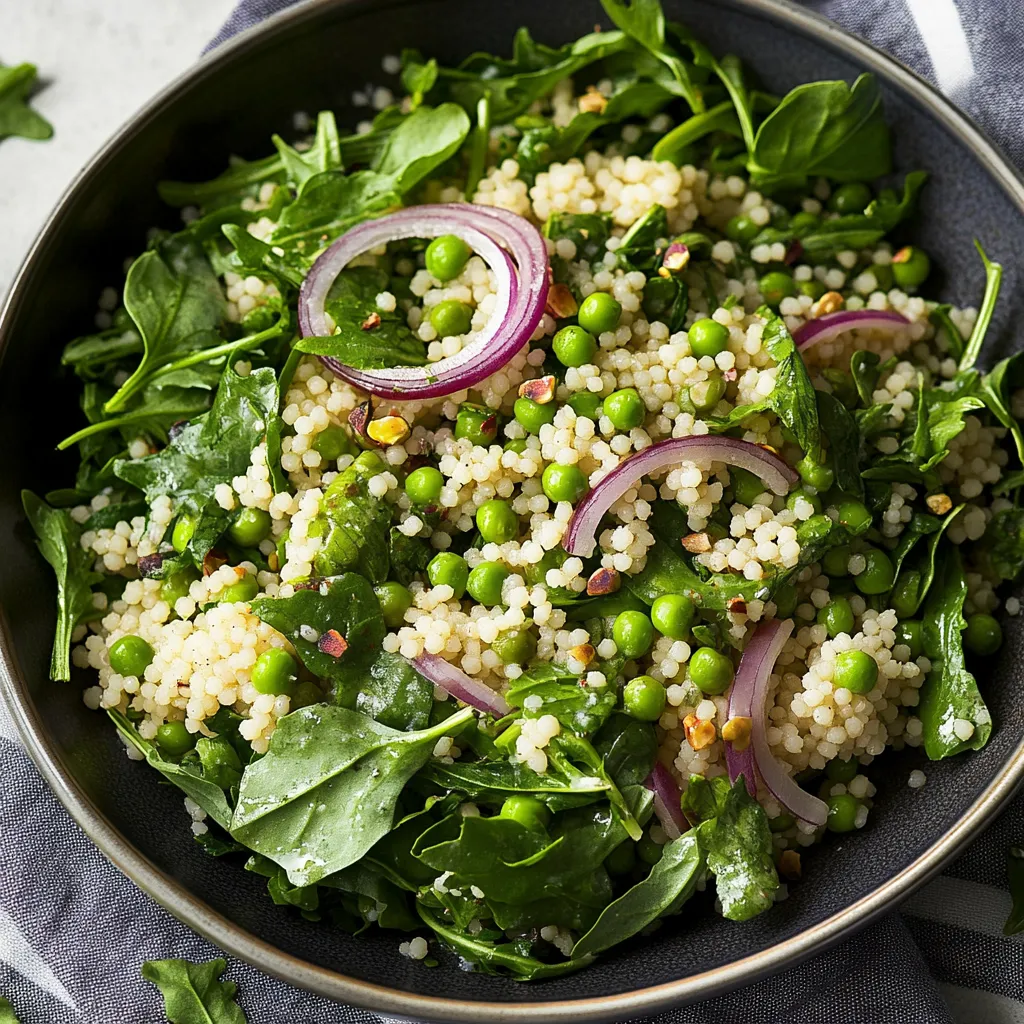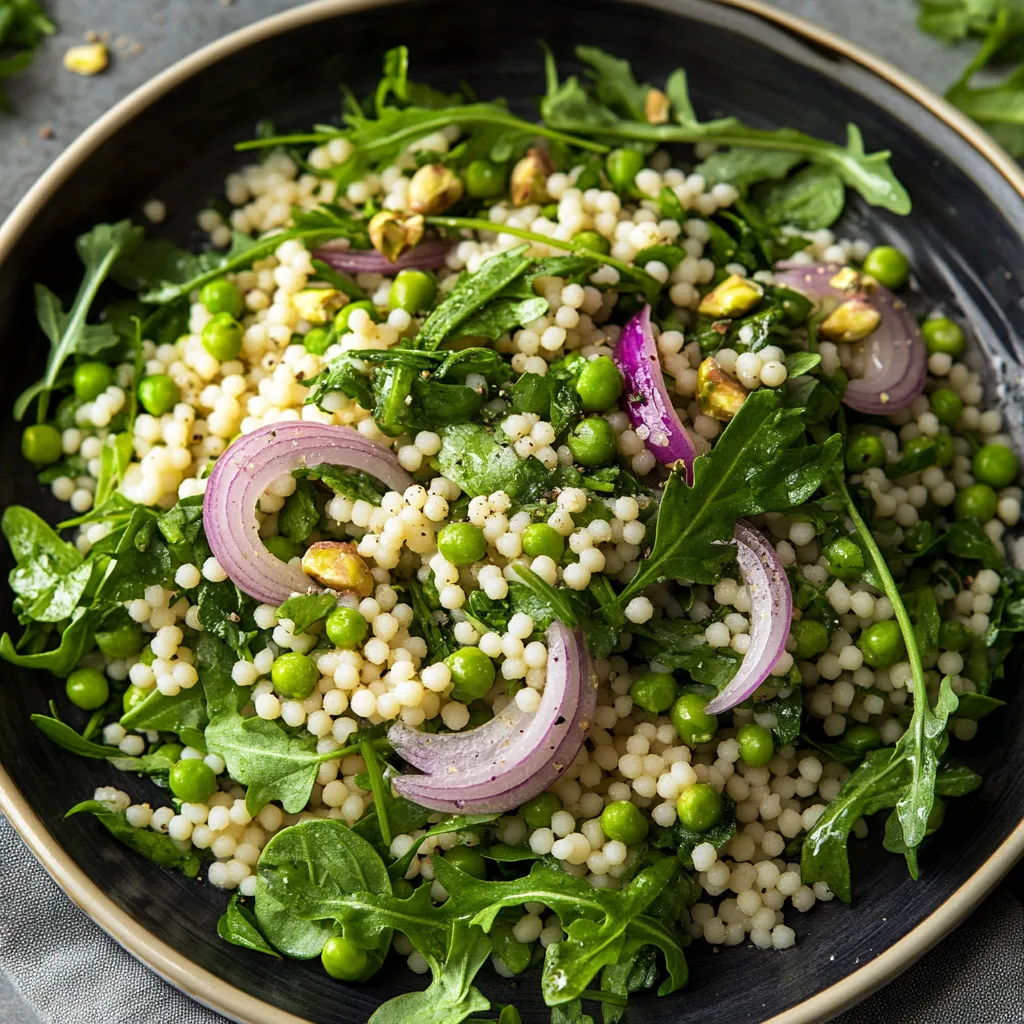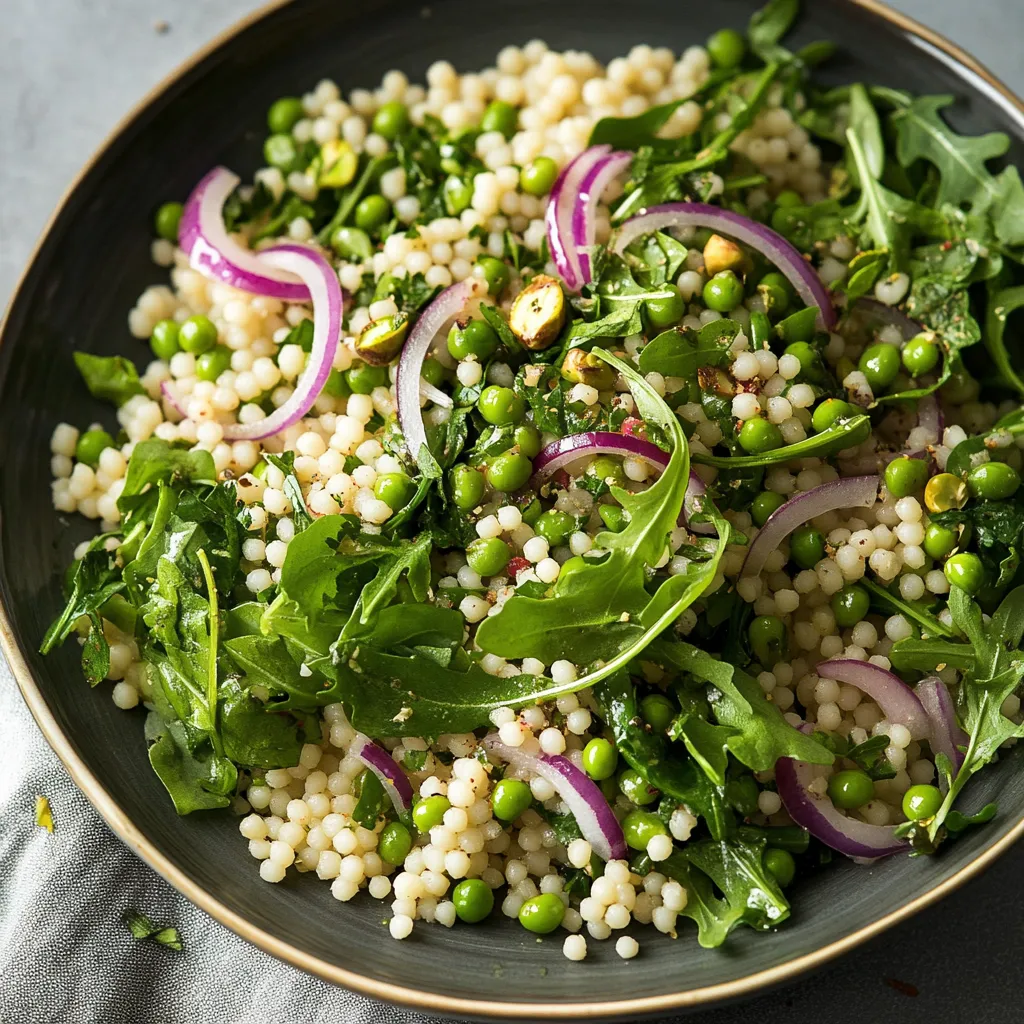 Pin it
Pin it
This spring couscous salad combines the vibrant flavors of fresh herbs, tender peas, and nutty pearl couscous for a refreshing meal that perfectly captures the essence of the season. The bright lemon-marinated onions and aromatic za'atar dressing elevate this simple dish into something truly special.
I first created this salad when my farmers market was overflowing with the first spring peas of the season. Now it has become my go-to dish for everything from casual lunches to dinner parties where I need something impressive but effortless.
Ingredients
- Pearl couscous: Forms the hearty base of this salad with its delightful chewy texture, choose Israeli or Lebanese varieties for authentic flavor
- Fresh English peas: Provide sweet pops of brightness, look for firm pods with no yellowing
- Red onion: Adds sharp contrast when mellowed by lemon juice, select smaller onions for milder flavor
- Arugula: Contributes peppery notes that balance the dish, fresh young leaves work best
- Fresh mint and parsley: Bring essential herbaceous elements, use only bright green bunches without wilting
- Pistachios: Add necessary crunch and nutty depth, buy them already shelled to save time
- Zaatar spice blend: Infuses Mediterranean character, authentic mixes with wild thyme are worth seeking out
- Lemon juice and zest: Provide crucial acidity, organic unwaxed lemons yield the best flavor
Step-by-Step Instructions
- Blanch the peas:
- Fill a medium pot with water and bring to a rolling boil. Add peas and cook for exactly 90 seconds. This precise timing ensures they maintain their sweet flavor and slight bite without becoming mushy. Immediately drain in a colander and rinse with cold water to stop the cooking process.
- Cook the couscous:
- Using the same pot you blanched the peas in, add 1½ cups water, 1 teaspoon salt, and couscous. Bring to a boil, then reduce heat to low and partially cover. Simmer gently for 8 to 10 minutes until water absorbs and pearls are tender yet still slightly al dente. Remove from heat, cover completely, and allow to steam for 5 additional minutes. This resting period ensures perfectly cooked grains.
- Marinate the onions:
- While couscous cooks, combine thinly sliced red onions with lemon juice, zest, and salt in a large mixing bowl. Toss thoroughly and let sit at least 5 minutes. This quick pickling process softens the harsh bite of raw onion while infusing them with citrus brightness.
- Prepare the herbs and nuts:
- Finely chop the mint and parsley ensuring no large stems remain. Roughly chop arugula into manageable pieces to create balanced forkfuls. Chop pistachios coarsely, leaving some larger pieces for textural interest throughout the salad.
- Make the zaatar dressing:
- In the same pot used for couscous, heat olive oil over medium heat. Add minced garlic and cook until just turning golden, about 2 minutes, stirring constantly to prevent burning. Immediately remove from heat and stir in zaatar, cumin, and salt. This blooming technique releases the essential oils in the spices dramatically enhancing their flavor.
- Assemble the salad:
- Add the cooled couscous to the bowl with marinated onions. Add blanched peas, chopped herbs, arugula, and pistachios. Pour the warm zaatar dressing over everything and gently fold until thoroughly combined. The residual warmth from the dressing will slightly wilt the greens and bloom the herbs.
 Pin it
Pin it
The za'atar spice blend is truly the secret star of this recipe. The first time I served this at a dinner party, a friend immediately asked for the recipe after just one bite. I always keep a jar of quality za'atar in my pantry now — its herbaceous thyme notes and tangy sumac create magic in even the simplest dishes.
Make Ahead Tips
This couscous salad actually improves with time as the flavors meld together beautifully. You can prepare it completely up to 24 hours in advance and store in an airtight container in the refrigerator. If making ahead, add the arugula just before serving to maintain its texture and appearance. I recommend bringing the salad to room temperature before serving to enhance the flavors.
Ingredient Substitutions
No pearl couscous? Regular couscous or even farro can work beautifully as a base. For a gluten-free option, quinoa makes an excellent substitute; just reduce the cooking water slightly. Frozen peas can replace fresh when not in season; just thaw them completely and skip the blanching step. If pistachios are unavailable, try toasted almonds or pine nuts for similar textural contrast.
Seasonal Adaptations
While designed as a spring dish, this salad transforms beautifully throughout the year. In summer, replace peas with diced cucumber and cherry tomatoes. Fall versions work wonderfully with roasted butternut squash and dried cranberries. Winter adaptations might include roasted root vegetables and pomegranate seeds. The versatile base recipe welcomes these seasonal variations while maintaining its Mediterranean character.
 Pin it
Pin it
Bring this salad to any gathering for guaranteed compliments. Its versatility and vibrant flavors make it an instant hit!
Frequently Asked Questions
- → Can I make this Spring Couscous Salad ahead of time?
Yes! You can prepare the components up to a day ahead. Cook the couscous and peas, and prep the herbs and marinade separately. Toss everything together up to 2 hours before serving. For best flavor and texture, add the arugula just before serving to prevent wilting.
- → What is za'atar and where can I find it?
Za'atar is a Middle Eastern spice blend typically containing dried thyme, oregano, marjoram, sumac, and toasted sesame seeds. You can find it in specialty grocery stores, Middle Eastern markets, or the international aisle of well-stocked supermarkets. You can also make your own by combining equal parts dried thyme, sesame seeds, and sumac with a pinch of salt.
- → Can I substitute another grain for the pearl couscous?
Absolutely! Quinoa, farro, or bulgur wheat make excellent alternatives to pearl couscous in this salad. Adjust cooking times according to package instructions. Each grain will bring a slightly different texture and flavor to the dish while maintaining its Mediterranean profile.
- → What can I use instead of arugula?
If you don't have arugula, baby spinach provides a milder flavor, while watercress offers a similar peppery bite. Mixed spring greens or baby kale also work well. The key is choosing tender greens that complement the herbs and don't overwhelm the other ingredients.
- → How can I make this salad vegan?
This salad is naturally vegan as written! All ingredients—couscous, vegetables, herbs, pistachios, and the olive oil-based dressing—are plant-based. Just ensure your za'atar blend doesn't contain any dairy additives (most commercial blends are vegan).
- → What protein would pair well with this salad?
For a complete meal, try adding grilled chicken, crispy tofu, chickpeas, or grilled halloumi cheese. For seafood lovers, seared shrimp or flaked salmon complement the Mediterranean flavors beautifully. The bright, herbaceous profile of the salad pairs well with most proteins.
